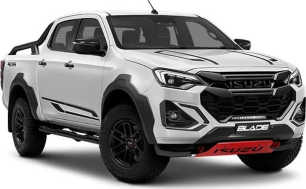On sealed surfaces, the Triton is punchy off the mark if you pressure it, and it’s surprisingly smooth and refined at highway speeds, simply trucking along.
A new chassis frame, redesigned suspension, longer wheelbase, and wider wheel track, all contribute to the Triton exhibiting more controlled and comfortable ride and handling than ever before.
With its new suspension design – high-mounted double wishbone with coil spring and stabiliser bar up front and leaf springs at the rear – the Triton feels more settled and composed, more sure-footed on bitumen roads and gravel tracks, in terms of ride and handling.
The power-assisted steering offers a light but precise feel, the engine has a quiet refinement about it, and the six-speed auto is clever enough to not warrant any legitimate criticism.
So, getting to and from your favourite 4WDing track or campsite is a whole lot more comfortable now than in previous Tritons. But how does this new bigger Triton go when it comes to low-range 4WDing?
Well, it's actually quite impressive.
The previous-generation Triton had a shorter bonnet, so driver visibility when you are 4WDing is a whole lot better because the new-generation Triton has quite a substantial bonnet, so your vision forward of the vehicle is somewhat impaired, but that is rectified, to a certain degree by a 360-degree camera, and that will operate while you are low-range 4WD or driving at low speeds.
That camera gives you a view to the side and rear of the vehicle and, more importantly, to the front of the vehicle so you can maintain your correct line on the track.
The Triton has strong and sharp throttle response, which is very handy while 4WDing when you need to instantaneously tap into that torque.
The GLX-R benefits from having Super Select 4WD-II onboard, which lower-spec variants do not get it.
I’ve sung the praises of this system many times before and it constitutes a major and crucial point of difference that Tritons or Pajero Sports (equipped with this system) have with their rivals.
Super Select 4WD-II adds an extra element of safety and sure-footedness to driving. Via a dial to the rear of the auto shifter, you can switch from 2H into 4H (four-wheel drive, high-range) to give you the best traction possible in traction-compromised situations (i.e. rain-soaked blacktop, rough back-roads or dirt tracks peppered with loose rocks and potholes).
There's no risk of transmission wind-up when 4H is engaged in the GSR because the centre diff remains open.
Then turn the dial to 4HLc (four-wheel drive, high-range, locked centre diff) and you're ready to take on more difficult terrain but at lower speeds, because now the centre diff is no longer open.
If you want to tackle even more difficult terrain than high-range 4WD territory, turn the dial to 4LLc (four-wheel drive, low-range, locked centre diff) and the Triton has the opportunity to excel in low-speed, low-range four-wheel driving.
This Triton also has a rear diff lock, which is engaged/disengaged via a button in front of the shifter and this further helps you to comfortably maintain safe forward momentum.
The GLX-R also has selectable off-road modes, including Gravel, Sand, Mud/Snow (when in high-range 4WD) and Rock (when in low-range 4WD). Each of these modes adjusts engine output, transmission settings and braking, the aim being optimal traction to suit specific conditions and terrains.
This new-gen Triton is a bigger vehicle with a longer wheelbase and a turning circle of 12.4m, so it doesn’t feel as nimble on bush tracks as the previous Triton.
And because of its size, you do have to drive this new-generation Triton with more focus than you might've gotten away with in the old Triton simply because it now takes up more space on the track than it ever has before.
The Triton’s ground clearance (a listed 228mm) and off-road angles – 30.4 degrees approach, 22.8 degrees departure and 23.4 degrees rampover – all check out and are standard for a ute of this kind, however, the Triton does feel low and vulnerable to scraping that underbody on rocks, sticks, tree roots, etc.
It does have what Mitsubishi describes as “heavy duty” underbody protection (there’s a plastic bash plate towards the front of the vehicle and a steel bash plate behind that). That underbody protection does seem quite substantial, but I wouldn't rely on those to cop severe punishment.
The rear diff housing also seems prone to copping a solid knock or two, especially if you're tackling some hard-core rock-climbing, steep hills or severely rutted downhill crawls.
The GLX-R does not have side steps, which makes it look and feel a bit taller off the deck, but that does mean that if the vehicle tips to the side at a severe angle – for example, while driving through a deep high-sided rut – the bottom edge of a door or the bottom of the chassis may take the full brunt of the hit, rather than a sidestep copping the worst of the knock.
Another niggle – and it's a trait of most contemporary 4WDs straight out of the showroom – is the fact that the GLX-R gets a set of tyres – Maxxis 790 Bravo (265/60R18) – that are better suited to the highway than they are to any even mild 4WD terrain. However, it’s easily remedied: just swap in a set of decent all-terrain tyres – go as gnarly as you want – and that will make this capable 4WD even more capable.
Otherwise, all the good stuff is here: the mechanicals (Super Select 4WD-II etc.), the off-road traction control system is well calibrated, and the rear diff lock is easily engaged and disengaged at the press of a button.
Towing capacity is 750kg (unbraked) and, worth noting, is the Triton’s braked towing capacity has increased to 3500kg (up from 3100kg), bringing it up to par with its dual-cab rivals.
Kerb weight is 2120kg, maximum payload is 1080kg, GVM is 3200kg, and GCM is 6250kg.






























